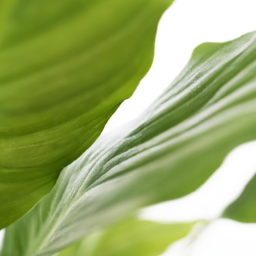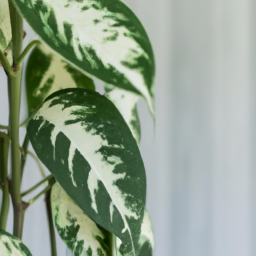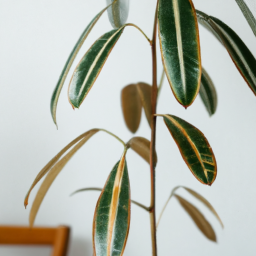
If you’re looking to add some greenery to your home, a house plant tree might be just the thing you need. These tall, leafy plants can add a touch of nature to any room and can even help purify the air. With so many varieties to choose from, there’s sure to be a house plant tree that fits your style and space. In this blog post, we’ll explore the world of house plant trees and discuss some tips for caring for these beautiful plants. Whether you’re a seasoned plant parent or just starting out, there’s something for everyone to learn about these versatile and stunning additions to your indoor garden.
Benefits of Having a House Plant Tree in Your Home
Improved Air Quality
House plant trees are not only beautiful additions to your home decor, but they also have numerous health benefits. One of the most significant advantages of having a house plant tree in your home is improved air quality. Plants absorb carbon dioxide and release oxygen through the process of photosynthesis, which helps to purify the air in your home. In addition, house plant trees can also remove harmful toxins such as formaldehyde, benzene, and trichloroethylene from the air, making your indoor environment healthier and more pleasant to be in.
Furthermore, house plant trees can help to increase humidity levels in your home, which can be especially beneficial during the dry winter months when indoor air tends to be drier. This can help to reduce respiratory problems, dry skin, and other issues caused by low humidity levels. Overall, having a house plant tree in your home can significantly improve the quality of the air you breathe and contribute to a healthier living environment.
In addition to their air-purifying qualities, house plant trees can also help to reduce stress and anxiety levels. Studies have shown that being around plants can have a calming effect on the mind and body, helping to lower blood pressure and promote relaxation. Having a house plant tree in your home can create a sense of tranquility and connection to nature, which can be especially beneficial in today’s fast-paced and stressful world.
Moreover, house plant trees can also help to boost productivity and creativity. Research has shown that being around plants can improve concentration, memory, and cognitive function. Having a house plant tree in your workspace or home office can help to create a more conducive environment for work and study, leading to increased productivity and inspiration. In addition, the presence of plants can help to stimulate creativity and problem-solving skills, making them a valuable addition to any creative or innovative endeavor.
Enhanced Aesthetic Appeal
In addition to their health benefits, house plant trees can also enhance the aesthetic appeal of your home. With their lush foliage, unique shapes, and vibrant colors, house plant trees can add a touch of natural beauty and elegance to any room. Whether you prefer a tall and majestic fiddle leaf fig tree or a cascading pothos plant, there are countless varieties of house plant trees to choose from to suit your personal style and decor preferences.
Furthermore, house plant trees can help to create a sense of warmth and coziness in your home. Their presence can help to soften harsh lines and add a touch of greenery to indoor spaces, making them feel more inviting and welcoming. Whether you place a house plant tree in a sunny corner of your living room or use it as a focal point in your entryway, it can help to create a more harmonious and visually appealing environment.
Additionally, house plant trees can also serve as natural focal points and conversation starters in your home. Whether you choose a statement-making palm tree or a striking rubber plant, a house plant tree can become a captivating centerpiece that draws the eye and adds interest to your decor. By incorporating house plant trees into your interior design, you can create a more dynamic and visually engaging space that reflects your personality and style.
In conclusion, having a house plant tree in your home can offer a wide range of benefits, from improved air quality and reduced stress to enhanced aesthetic appeal and increased productivity. Whether you are a seasoned plant enthusiast or a novice green thumb, adding a house plant tree to your indoor space can bring beauty, health, and joy into your life. So why wait? Bring home a house plant tree today and experience the many wonders it has to offer.

Tips for Choosing and Caring for a House Plant Tree
Choosing the Right House Plant Tree
When selecting a house plant tree, there are a few key factors to consider to ensure it thrives in your home. First, think about the amount of light the tree will receive in its designated spot. Some house plant trees, such as the Fiddle Leaf Fig, require bright, indirect light, while others, like the Snake Plant, can tolerate lower light conditions.
Next, consider the size of the tree and how much space you have available. Some house plant trees, such as the Rubber Plant, can grow quite large over time, so make sure you have enough room for it to spread out. Additionally, think about the care requirements of the tree and whether you are able to provide the necessary water, humidity, and temperature levels it needs to thrive.
Lastly, choose a house plant tree that fits your aesthetic preferences and complements your home decor. There are a wide variety of house plant trees to choose from, ranging from the sleek and modern ZZ Plant to the tropical and exotic Bird of Paradise. Consider the style of your home and the atmosphere you want to create when selecting a house plant tree.
Once you have chosen the right house plant tree for your home, it’s important to properly care for it to ensure it stays healthy and vibrant.
Caring for Your House Plant Tree
Proper watering is essential for the health of your house plant tree. Different species have different water requirements, so be sure to research the specific needs of your tree. In general, it’s best to water your house plant tree when the top inch of soil feels dry to the touch. Avoid overwatering, as this can lead to root rot and other issues.
In addition to watering, house plant trees benefit from regular fertilization to provide essential nutrients for growth. Use a balanced liquid fertilizer once a month during the growing season to keep your tree healthy and thriving. Be sure to follow the instructions on the fertilizer packaging to avoid over-fertilizing, which can harm your tree.
Proper humidity levels are also important for house plant trees, especially tropical varieties. To increase humidity around your tree, you can mist the leaves regularly, place a humidifier nearby, or group your house plant trees together to create a microclimate. Monitor the humidity levels in your home and adjust as needed to keep your tree happy.
Regularly inspect your house plant tree for signs of pests or disease, such as yellowing leaves, brown spots, or webbing. If you notice any issues, take action immediately to prevent further damage. You can use natural remedies like neem oil or insecticidal soap to treat pests, or consult with a professional if the problem persists.
By following these tips for choosing and caring for a house plant tree, you can enjoy the beauty and benefits of indoor greenery in your home. Remember to research the specific needs of your tree and provide the proper care to help it thrive for years to come.

Popular Varieties of House Plant Trees for Indoor Gardening
Fiddle Leaf Fig
The Fiddle Leaf Fig, scientifically known as Ficus lyrata, is a popular choice for indoor gardening due to its large, glossy leaves that resemble a fiddle or violin. This tree can grow up to 10 feet tall and requires bright, indirect light to thrive. It is important to rotate the plant regularly to ensure even growth on all sides.
When caring for a Fiddle Leaf Fig, it is essential to water it when the top inch of soil is dry and to avoid overwatering, as this can lead to root rot. Regularly wiping the leaves with a damp cloth will help prevent dust buildup and keep the plant looking healthy and vibrant.
Propagation of the Fiddle Leaf Fig can be done through stem cuttings, which should be taken in the spring or summer months. This tree is a stunning addition to any indoor space and is sure to make a statement with its bold foliage.
Rubber Plant
The Rubber Plant, or Ficus elastica, is another popular house plant tree known for its broad, dark green leaves and striking appearance. This tree can grow up to 8 feet tall and thrives in bright, indirect light. It is important to keep the soil consistently moist but not waterlogged to prevent root rot.
Regular pruning of the Rubber Plant will help maintain its shape and encourage new growth. This tree is relatively low-maintenance and can adapt well to different light conditions, making it suitable for various indoor environments. Fertilize the plant every 2-4 weeks during the growing season to promote healthy growth.
Propagation of the Rubber Plant can be done through air layering or stem cuttings, with the latter being the more common method. With proper care and attention, the Rubber Plant can add a touch of elegance to any indoor space.
Money Tree
The Money Tree, or Pachira aquatica, is a unique house plant tree with braided trunks and bright green, palmate leaves. This tree is believed to bring good luck and prosperity to its owner, making it a popular choice for indoor gardening. The Money Tree thrives in bright, indirect light and prefers to dry out slightly between waterings.
Regularly misting the leaves of the Money Tree will help increase humidity levels and prevent dust buildup. This tree is relatively resilient and can adapt well to different light conditions, making it suitable for beginners and experienced gardeners alike. Fertilize the plant every 4-6 weeks during the growing season to promote healthy growth.
Propagation of the Money Tree can be done through stem cuttings, which should be taken in the spring or summer months. With its unique appearance and symbolic significance, the Money Tree is a popular choice for adding a touch of charm to any indoor space.
Highlights of this article
So you’ve finally decided to bring some greenery into your home by adding a house plant tree. These beautiful and versatile plants can instantly add a touch of nature to any room, while also providing numerous health benefits. House plant trees come in all shapes and sizes, from tall and slender to short and bushy, so there’s sure to be one that fits perfectly in your space.
Not only do house plant trees help purify the air in your home by removing toxins and releasing oxygen, but they can also improve your mood and reduce stress levels. With the right care and attention, your house plant tree can thrive for years to come, bringing a little piece of the outdoors inside. So why not add a touch of green to your home with a beautiful house plant tree today?
Your Questions Answered. Comprehensive FAQ:
Q1: What are some popular house plant trees?
A1: Some popular house plant trees include the Fiddle Leaf Fig, Rubber Plant, and Money Tree. These trees are not only beautiful additions to your home decor but also relatively easy to care for.
Q2: How do I care for a house plant tree?
A2: House plant trees generally require bright, indirect light, regular watering (but not overwatering), and occasional fertilization. It’s also important to check for pests and diseases regularly and prune as needed.
Q3: Can I grow a house plant tree from a cutting?
A3: Yes, many house plant trees can be propagated from cuttings. Simply take a cutting from a healthy plant, allow it to dry out for a few hours, then plant it in soil or water and wait for roots to develop.
Q4: How often should I repot my house plant tree?
A4: House plant trees should be repotted every 1-2 years, or when their roots outgrow their current pot. Choose a pot that is slightly larger than the current one and use fresh, well-draining soil.
Q5: Are house plant trees safe for pets?
A5: While many house plant trees are safe for pets, some can be toxic if ingested. It’s important to research each specific plant before bringing it into a home with pets, and to place them out of reach if necessary.
Emily Bloomfield is an interior designer and horticulturist specializing in incorporating indoor plants into interior spaces. With a background in both design and plant science, Emily offers a unique perspective on creating harmonious living environments through the synergy of greenery and aesthetics. Her creative ideas and innovative solutions make her a sought-after authority in the field.


